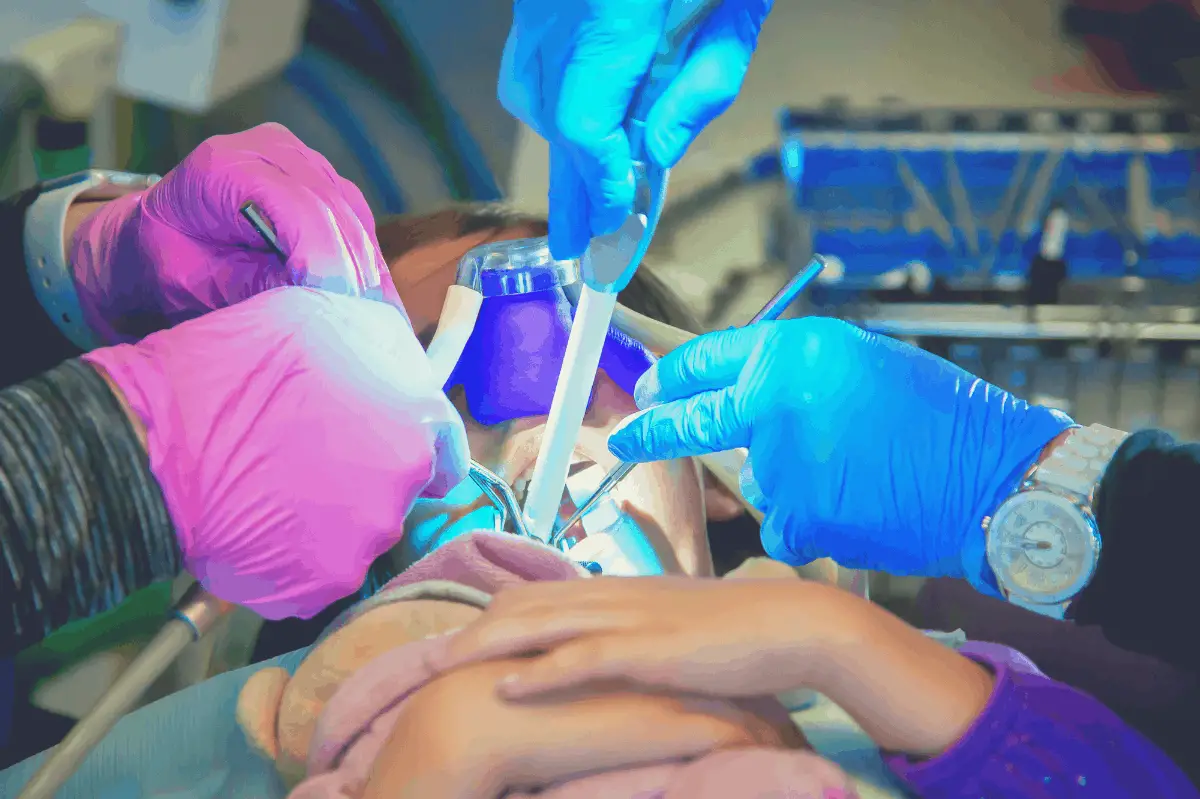Does the thought of undergoing a dental procedure such as wisdom teeth removal make you cringe? You’re not alone. The feeling of dentists prodding the mouth with different tools during one procedure or another can be deeply uncomfortable at best and usually painful.
The good news is that dental professionals administer sedatives or anesthetics to patients to reduce their pain and anxiety. One of the most popular options in the dental industry is Nitrous Oxide, also known as Laughing Gas.
Does laughing gas put you to sleep?
The answer is no. A combination of laughing gas and oxygen administered via a face mask can numb the patient’s level of pain and discomfort during dental procedures but he or she stays wide awake from start to finish.
Benefits of Using Laughing Gas As Anesthesia
There are multiple reasons why nitrous oxide has become an anesthetic of choice among dentists and other healthcare professionals. Shall we take a look at a couple of the benefits of the popular gas?
1. Reduces Anxiety and Pain
Many dental procedures can be downright uncomfortable and painful. However, the majority of them may be a necessity to keep the mouth healthy by preventing odors, bacterial invasions, and poor oral health in general.
From root canals to crowns as well as dental implants and gum tissue grafts, the amount of pain associated with many dental procedures can be so severe that the average person may need some help to get through it.
The good news is that inhaling laughing gas can provide a sense of euphoria that may reduce the degree of pain a patient feels. This should allow dentists to perform even the most painful procedures with little interruption from patients.
2. Fast Results After Administration
The average anesthesia for surgery takes approximately 30 minutes for its effects to kick in. In the meantime, anesthesiologists and nurses are forced to monitor the patient’s heart rate and other vital statistics from top to bottom.
On the contrary, nitrous oxide can provide quick results after breathing in. Experts say it takes about 3 minutes of inhalation for the patient to begin feeling its euphoric effects. This can be a great time-saver for both dentists and patients.
Thus, laughing gas allows dental professionals to conduct a higher number of procedures for patients within a specific time-frame. And the fact that laughing gas produces almost instant results means patients are not forced to spend unnecessary amounts of time in the dentist’s office upon completion of a procedure.
3. A Good Alternative to Local or General Anesthesia

The combination of laughing gas and oxygen can be a great alternative to local or general anesthesia. Fortunately, the mild effects of nitrous oxide make it an effective option for administration in the dentist’s office.
This is unlike general anesthesia which is only legally permitted to be administered in a hospital under the supervision of a licensed anesthesiologist.
As such, laughing gas is less complicated and remains an easy option for dentists who want to avoid the hassle of leaving their offices to conduct procedures for patients.
4. Completely Safe
Nitrous oxide can be a completely safe form of anesthesia when administered by a qualified professional. Setting up the gas for inhalation is easy and multiple extensive studies have found no detrimental effects on the lungs, heart, liver, and other critical organs.
Many professionals typically advise patients to avoid getting up abruptly after inhaling the gas due to an increased risk of tripping or falling.
But besides that, as long as you follow all the tips and techniques offered by the dental technician, nurse, or dentist, there should be no surprises after undergoing nitrous oxide administration.
5. No Hangover Effects
Using laughing gas to numb a patient’s pain during medical procedures produces zero hangover effects on the body. This is in sharp contrast to local and general anesthesia which may leave a ton of side effects.
Popular drugs used in local and general anesthesia are notorious for acting on the brain and resulting in hangovers. Some of the most common side effects of powerful anesthetics on the brain may include:
- Nausea
- Dizziness
- Puffy eyes
- Sore throat
- Muscle aches
- Itching
- Hypothermia
6. Quick Return to Normal Daily Life

Most patients who are sedated with nitrous oxide drive back home by themselves with no impairments to their cognitive functioning. This is because the mild sedative takes about 5 minutes to exit the body entirely.
Hence, anyone can pop in for a quick appointment with their dentist under laughing gas anesthesia and return to work or school afterward without problems. This is in sharp contrast to other anesthetics that may knock patients off their feet for several hours before normal brain functioning can resume.
You can always inquire from your dentist about being sedated with laughing gas for procedures when you’re busy and cannot afford to lose a day or two.
7. Tried and Tested Over Centuries
Laughing gas has been tried and tested over centuries and proven to be an effective method of providing mild sedation. Discovered in 1799 by Humphrey Davy, the gas has been used in a variety of applications for over two centuries.
Besides, administering the gas is easy and simply requires the patient to wear a mask that supplies the nitrous oxide together with oxygen.
Laughing gas on an Empty Stomach
One of the most common questions patients ask when scheduled for procedures that involve nitrous oxide sedation is whether they should eat something before.
Is it healthy to inhale laughing gas on an empty stomach? The answer is no. It is important to eat a light snack such as a sandwich or doughnut before being put under nitrous oxide sedation to prevent tummy issues.
However, avoid eating a big plate of food as that can increase the risk of nausea after the procedure.
Common Bad Reactions to Lauging gas
As stated above, laughing gas is generally safe and has been used for hundreds of years. While side effects are generally not common, a few patients have reported reactions such as:
- Headaches
- Nausea
- Fatigue
- Feverishness
- Sluggishness
- Chills and shivering
- Breathing problems
- Hives
The good news is that medical professionals typically continue to provide oxygen to the patient 5 minutes or so after switching off the laughing gas supply at the end of a procedure. This can effectively clear the gas from the body to minimize the risk of suffering any of these bad reactions above.
Laughing gas in Pediatric Dentistry
Laughing gas is popular in pediatric dentistry because it can help children calm down during a range of procedures. We all know that getting kids to sit still and focus during the simplest dental work can be difficult.
However, the administration of this anesthesia via a face mask can calm the child’s nerves and get him or her to sit quietly through any procedure. A dentist typically drapes the mask over the child’s face and asks him or her to breathe in and out through the mouth instead of the nostrils.
Nitrous Oxide may come with a slight, sweet smell that many kids find pleasant so getting him or her to commit to wearing it for the entire duration of the procedure may not be a problem.
Cavity fillings, in particular, is one of the most common dental works conducted on children. It usually involves a dentist giving the child’s gums a novocaine shot and drilling a tooth to enable the filling of the cavities.
The procedure may be excruciatingly painful for kids so the administration of Nitrous Oxide can come in handy. It can serve as a welcome distraction for the child’s pain and discomfort.
Upon completion of the filling, the dentist typically turns off the laughing gas while continuing to supply oxygen to the child. After about 5 minutes, the oxygen is then completely switched off.
Laughing gas As a Recreational Drug
Nitrous oxide is commonly used as a recreational drug due to its euphoric effects on the body. In the United States and other countries, buying laughing gas is completely legal and can be purchased by anyone from stores without a prescription or permit.
However, nitrous oxide inhalation can be an addictive and dangerous drug that may have devastating effects when abused. Unfortunately, there have been a few instances of laughing gas-related deaths in the United Kingdom and other parts of the world.
Additional side effects of nitrous oxide abuse may include:
- Dizziness
- Reduced or complete motor function loss
- Headaches
- Lethargy
- Painful joints and muscles
- General body weakness
- Unconsciousness
Alternatives For Laughing Gas Sedation During Medical Procedures
The benefits of using nitrous oxide during medical procedures can be enormous. However, there can be times when the use of the popular mild sedative may not be realistic.
For instance, patients with severe nasal congestion and other respiratory conditions may not be viable for nitrous oxide sedation. If you suffer severe anxiety from wearing any type of mask, doctors may have to look at different options to help reduce your discomfort during procedures.
A few alternatives to laughing gas include:
Oral Sedatives: Dentists may offer oral sedatives to the patient to calm down the nerves and numb his or her discomfort during potentially painful procedures. The most common oral pill offered before sitting in the dentist’s chair is Halcion, a member of the same drug family as Valium.
Deep Sedation: This can be a good alternative in the absence of nitrous oxide. Often, sedation is conducted and supervised by a board-certified anesthesiologist with the help of world-class medical equipment.
The drugs may be administered intravenously with a few medical professionals providing round-the-clock supervision to ensure the patient is adequately sedated, healthy, and comfortable.
Conclusion
Nitrous oxide or laughing gas does not put you to sleep unlike general anesthesia and other more powerful drugs that produce similar effects to tranquilizers. However, the colorless and odorless gas can deliver a feeling of euphoria which may reduce a person’s reaction to pain and discomfort.
This is why it is used as a mild sedative in the performance of many dental and medical procedures. The good news is that the effects of laughing gas are quick after inhalation especially when the patient breathes through the mouth.
These effects also wear off quickly once a person stops inhaling the popular gas.
